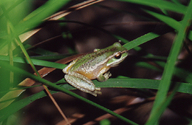|
Litoria subglandulosa Tyler and Anstis, 1983
New England Tree Frog, Sublime Tree Frog, Glandular Frog | family: Hylidae subfamily: Pelodryadinae genus: Litoria |
|
Taxonomic Notes: Following the Australian Society of Herpetology, AmphibiaWeb uses Litoria instead of Ranoidea or Dryopsophus (contrary to Dubois and Fretey 2016 and Duellman et al 2016). |
|
 © 2000 Sean Schoville (1 of 2) |
|
|
|
Description The tadpoles of L. subglandulosa grow up to 35mm in length and are reasonably typical tree frog tadpoles to look at except that they lack teeth or a beak, instead having a series of tentacle-like papillae around the mouth. This is exceptional amongst the tree frogs of Australia and what they eat is unknown, but of some curiosity. This frog is also very, very similar in appearance to the related species Litoria citropa (Blue Mountains Tree Frog). Fortunately, there is no overlap in the ranges and so individuals can be told apart simply by where there are found. They are broadly similar as well to the leaf green tree frogs (Litoria phyllochroa and Litoria pearsoniana groups), but can be clearly distinguished by a white lip and bright red-orange sides and thighs. Distribution and Habitat Country distribution from AmphibiaWeb's database: Australia
New England Tree Frogs are found in a range of habitats, both very natural and highly disturbed. They call along large permanent streams 5-10m in width, but also use very small streams that are no more than 50cm wide. They have been found in wet sclerophyll forest and rainforest, dry sclerophyll forest, montane woodlands and semi-cleared to cleared grazing lands. It appears that they will stay on a stream as long as there is some fringing vegetation. Furthermore, they are just as common in the highly modified landscapes as they are in those areas that are undisturbed; this frog is clearly quite adaptable in its habitat requirements. Life History, Abundance, Activity, and Special Behaviors What individuals do outside of breeding times is not clear, although frogs have been found in the surrounding forest moving around in low vegetation. Being a tree frog with prominent suckered toes, both species may be relatively arboreal in nature. They presumably eat invertebrates, but their diet has not been investigated. Trends and Threats Historical declines (more than 10 years/3 generations ago) so fails to meet IUCN criteria for declines. Missing from some sites, status at other sites not well known. Susceptible to various threats across its range. Habitat deterioration in parts of range. Threats include habitat modification due to removal of riparian vegetation, especially from grazing and timber harvesting. Introduced predators are also a threat; trout have been released into streams that support small populations of the frog. Comments
These two very beautiful tree frogs (I’ll refer to both species of Litoria as New England Tree Frogs) are very closely related, with Litoria daviesae having been split from Litoria subglandulosa in 2003 based on new genetic tests. Originally submitted by: Jean-Marc Hero et. al. (first posted 2002-05-04) Edited by: Ambika Sopory, Jean-Marc Hero, F. Lemckert, Kellie Whittaker (2008-09-19) Species Account Citation: AmphibiaWeb 2008 Litoria subglandulosa: New England Tree Frog <https://amphibiaweb.org/species/1308> University of California, Berkeley, CA, USA. Accessed May 29, 2025.
Feedback or comments about this page.
Citation: AmphibiaWeb. 2025. <https://amphibiaweb.org> University of California, Berkeley, CA, USA. Accessed 29 May 2025. AmphibiaWeb's policy on data use. |


 Map of Life
Map of Life